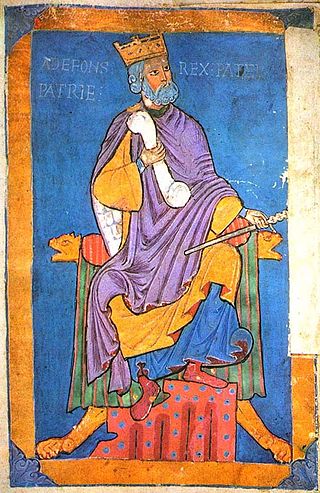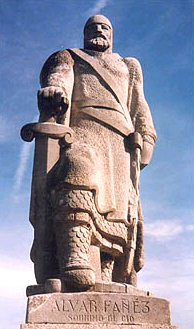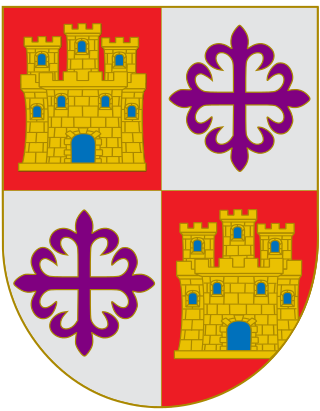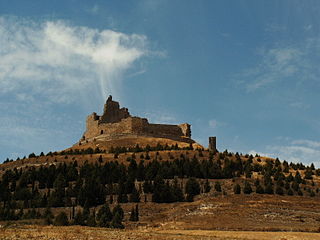
Alfonso VI, nicknamed the Brave or the Valiant, was king of León (1065–1109), Galicia (1071–1109), and Castile (1072–1109).

Sancho IV of Castile called the Brave, was the king of Castile, León and Galicia from 1284 to his death. Following his brother Ferdinand's death, he gained the support of nobles that declared him king instead of Ferdinand's son Alfonso. Faced with revolts throughout his reign, before he died he made his wife regent for his son Ferdinand IV.

Álvar Fáñez was a Leonese nobleman and military leader under Alfonso VI of León and Castile, becoming the nearly independent ruler of Toledo under Queen Urraca. He became the subject of legend, being transformed by the Poema de Mio Cid, Spain's national epic, into Álvar Fáñez Minaya, a loyal vassal and commander under Rodrigo Diaz de Vivar, El Cid, during the latter's exile and his conquest of Valencia.

García Ramírez, sometimes García IV, V, VI or VII, called the Restorer, was the King of Navarre (Pamplona) from 1134. The election of García Ramírez restored the independence of the Navarrese kingdom after 58 years of political union with the Kingdom of Aragon. After some initial conflict he would align himself with king Alfonso VII of León and Castile, and as his ally take part in the Reconquista.
Bermudo III or Vermudo III was the king of León from 1028 until his death. He was a son of Alfonso V of León by his first wife Elvira Menéndez, and was the last scion of Peter of Cantabria to rule in the Leonese kingdom. Like several of his predecessors, he sometimes carried the imperial title: in 1030 he appears as regni imperii Ueremundo principis; in 1029/1032 as imperator domnus Veremudius in Gallecia; and in 1034 as regni imperii Veremundus rex Legionensis. He was a child when he succeeded his father. In 1034 he was chased from his throne by King Sancho III of Pamplona and forced to take refuge in Galicia. He returned to power, but was defeated and killed fighting against his brother-in-law, Ferdinand of Castile, in the battle of Tamarón.
Zaida of Seville, c. 1070–1093/1107 (?), was a refugee Muslim princess, formerly associated with the Abbadid dynasty, who became a mistress and then perhaps wife of king Alfonso VI of Castile.
Sancho Alfónsez was the only son of King Alfonso VI of Castile and León; his mother was the Moorish princess Zaida. Alfonso's heir from May 1107, he eventually co-ruled from Toledo. He predeceased his father, being killed while trying to escape the field of the Battle of Uclés. His death, on his first recorded military expedition, precipitated a succession crisis that ended with the accession of his elder half-sister Urraca and her husband, Alfonso the Battler, already King of Navarre and Aragon, to the throne of Kingdom of Castile-León.

John of Castile, called the "el de Tarifa" was an infante of Castile and León. He was engaged in a decades-long fight for control over the Lordship of Biscay with Diego López V de Haro, the uncle of his wife.

Lope Díaz II de Haro "Cabeza Brava" was a Spanish noble of the House of Haro, the sixth Lord of Biscay, and founder of the municipality of Plentzia. He was the eldest son of Diego López II de Haro and his wife, María Manrique. Lope was also a member of the Order of Santiago.

Nuño González III de Lara was a Castilian noble of the House of Lara. He was the lord consort of Alegrete, Vide, and Sintra and served as Alférez del rey for King Ferdinand IV of Castile.
Sancho Garcés was an illegitimate son of King García Sánchez III of Pamplona and first cousin of King Alfonso VI of León. Lord of Uncastillo and Sangüesa, he was the father of Ramiro Sánchez whose son García Ramírez was the first of a new dynasty of Navarrese monarchs.

Enrique Enríquez the Younger was a nobleman of Castile, son of Enrique Enríquez the Elder. He was lord of Villalba de los Barros, Nogales, Almendral, La Parra, Begíjar and other towns. He was Adelantado Mayor of the border of Andalusia, chief justice of the King's House, Chief of the forces of the bishopric and Kingdom of Jaén, Mayor of Seville and Knight of the Band.
Fernando Flaínez was a powerful magnate from the Kingdom of León, member of the aristocratic lineage of the Flaínez. His parents were Flaín Muñoz and his wife Justa Fernández, daughter of count Fernando Bermúdez de Cea. He was the paternal grandfather of Jimena Díaz, wife of Rodrigo Díaz de Vivar El Cid, and the direct ancestor of the important medieval noble lineage of the Osorios. He married Elvira Peláez, daughter of Pelayo Rodríguez and Gotina Fernández de Cea, with whom he had at least seven children: Flaín, Oveco, Justa, Pedro, Pelayo, Muño and Diego. He was the tenente of Aguilar and documented with the title of count as of 1028. Jointly with his son, Flaín Fernández, he governed the city of León until 1038 when the kingdom was already under the control of King Sancho III of Pamplona.
Guillén Pérez de Guzmán, a member of the House of Guzmán, one of the most aristocratic of the Kingdom of Castile, was the maternal grandfather of Queen Beatrice of Castile, Queen Consort of Portugal as the wife of King Alfonso III. His father was Pedro Rodríguez de Guzmán—killed in the Battle of Alarcos on July 18, 1195 and son of Rodrigo Muñoz de Guzmán—and Mahalda With his brothers Nuño and Theobald, he fought alongside King Alfonso VIII at the decisive Battle of Navas de Tolosa in 1212. Even though his kinsmen supported the Laras during the crisis that ensued after the death of King Alfonso VIII, Guillén, probably because of his marriage to a member of the Girón clan, supported Queen Berengaria of Castile and her son, the future king Ferdinand III.

Gutierre Fernández de Castro was a nobleman and military commander from the Kingdom of Castile. His career in royal service corresponds exactly with the reigns of Alfonso VII (1126–57) and his son Sancho III (1157–58). He served Alfonso as a courtier after 1134 and as majordomo (1135–38). He was the guardian and tutor the young Sancho III from 1145. Before his death he was also briefly the guardian of Sancho's infant son, Alfonso VIII.

Gutierre Rodríguez de Castro also known as Gutierre Ruiz de Castro and nicknamed el Escalabrado was a Castilian nobleman, member of the House of Castro as the son of Rodrigo Fernández de Castro and his wife Elo Álvarez, daughter of Álvar Fáñez and his wife Mayor Pérez, daughter of Count Pedro Ansúrez.

Aldonza Martínez de Silva a Portuguese noblewoman, daughter of Martim Gomes da Silva and his wife Urraca Rodríguez, was one of the mistresses of King Alfonso IX of León and afterward, the wife of Diego Froilaz.
The Banu Gómez were a powerful but fractious noble family living on the Castilian marches of the Kingdom of León from the 10th to the 12th centuries. They rose to prominence in the 10th century as counts in Saldaña, Carrión and Liébana, and reached their apogee when, allied with Córdoba warlord, Almanzor, their head, García Gómez, expelled king Vermudo II of León and briefly ruled there. He would reconcile with the royal family, but launched two subsequent rebellions. On his death, the senior line of the family was eclipsed, but a younger branch would return to prominence, producing Pedro Ansúrez, one of the premier noblemen under king Alfonso VI and queen Urraca in the late 11th and early 12th centuries. The family would be portrayed in the Cantar de Mio Cid as rivals and antagonists of the hero, El Cid, and their rebellions would serve as a basis for the legend of Bernardo del Carpio.
Violante Sánchez of Castile, was a Castilian noblewoman and by marriage Lady of Lemos, Sarria, Cabrera and Ribera.
Juan de Tovar or Juan Fernández de Tovar, later known as Martín Fernández de Tovar, was a Castilian nobleman, belonging to the House of Tovar, Lord of the villages of Cevico de la Torre and Caracena, and Chief-guard to King Henry IV of Castile. After the monarch's death, he did not recognize the king's half-sister, Princess Isabella, as sovereign, thus joining the party of the Marquis of Vilhena, Juan Pacheco, and the Archbishop of Toledo, Alfonso Carrillo, in support of the king's alleged daughter, Joanna la Beltraneja, and her husband Afonso V, King of Portugal. For this reason, Tovar had the lordships of Cevico and Caracena confiscated in 1489 by the Catholic Monarchs, who sentenced him to death, and fled to France the following year. In Portugal, he was known by the name Martim Fernandes de Tovar, for having aligned himself with King Afonso V against the Catholic Monarchs and in favour of Joanna la Beltraneja. He was also known as the father of the navigator Sancho de Tovar and as the head of the Tovar family in the country.














